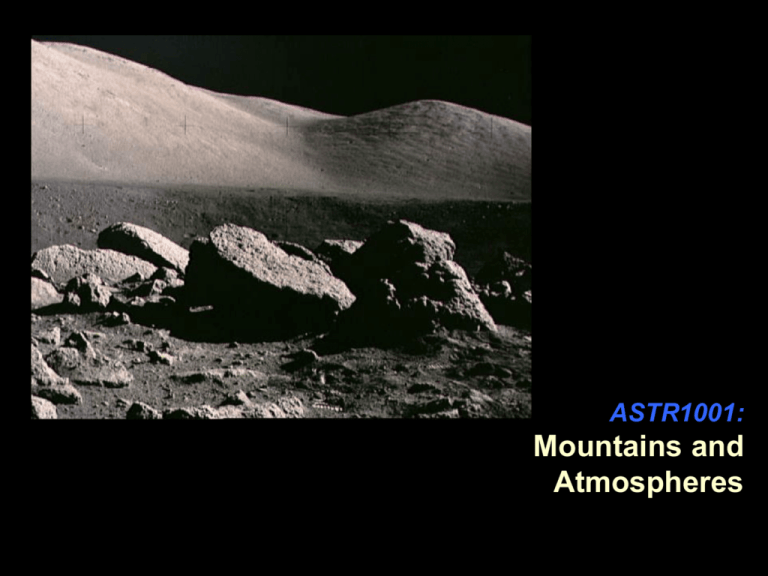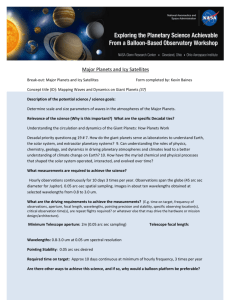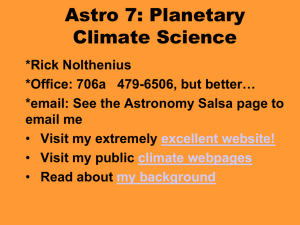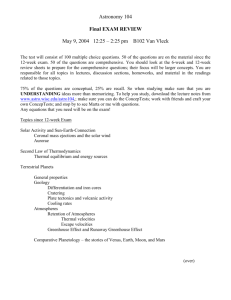mountains
advertisement

ASTR1001: Mountains and Atmospheres Summary In this section, we will talk about the mountains of different planets, and about their atmospheres. • Puzzle 1 - why are small objects much lumpier than big ones? • Puzzle 2 - why do the atmospheres of planets vary so much. Big planets are highly circular. Things are very different for small planets Why? Surface gravity limits the size of mountains - it turns out that the Himalayas on Earth are about as high as it is possible to get without the rocks beneath them liquefying under the pressure (ie. 9km). How does surface gravity vary on different planets? The mass of a planet of density r and radius r is 4 3 M r r 3 Surface Gravity So how can we work out the surface gravity of a planet? The acceleration of an object at the surface (9.81 m/s on Earth) is simply the gravitational force divided by its mass. Newton’s law gives the gravitational force. 4 3 G rr F GM 4 3 a 2 G r r 2 m r 3 r Gravity correlates with Size So, other things being equal, the surface gravity of a planet correlates with its size. Thus mountains on a planet like Mars, 1/3 the size of the Earth, can be up to three times higher, as indeed they are. On an asteroid, mountains can be almost as big as the asteroid itself! This is one way to see their irregular shapes. 433 Eros So what is the gravity on an asteroid, such as 433 Eros? It is 40km long, and has a density typical of rock (ie. 3000 kg per cubic metre). Thus the gravitational acceleration on the surface is a=1.6 cm s-2. If you dropped a pen, it would take 11 seconds to hit the ground. How high could you jump, and how long would it take you to come down again? You would be up for ten minutes, reaching nearly a km in altitude. Atmospheres: big planets are all atmosphere Medium sized planets have moderate atmospheres Small planets have no atmospheres Atmospheres Big planets have atmospheres of Hydrogen and Helium (plus trace amounts of other elements). Medium planets such as the Earth have atmospheres of nitrogen, carbon dioxide etc. Small planets have no atmospheres. Why? One theory says that planets all started off with the same chemical composition. How then did the small planets loose so much gas? Escape velocity Remember - the gravitational potential energy of an object a distance r from the centre of a planet is: GMm PE r If an object is moving so fast that its kinetic energy exceeds this, it can escape out into space, never to return. Thus 1 2 GMm mv 2 r How Fast? Thus the escape velocity is: v 2GM r But can the air escape? Statistical thermodynamics tells us that the average kinetic energy of a molecule of gas of mass m, at a temperature T, is 1 2 3kT KE mv 2 2 Where k is Boltzmann’s Constant. This is the average speed - the fastest molecules will be travelling roughly ten times as fast. Thus the velocity of the fastest molecules in an atmosphere will be: 3kT v ~ 10 m If this velocity is comparable to the escape velocity, then molecules of this type can escape into space. Thus the condition for escape is: 3kT 2GM 10 m r So for a planet of mass M and radius r, there is a minimum mass of gas molecule which can stay in its atmosphere. 150kTr m GM What is the value of this minimum mass? Earth k=1.38x10-23J/K G=6.67x10-11Nm2kg-2 M=5.97x1024kg T=300K r=6.4x106m So the minimum mass is 1.0x10-26kg This is more than the mass of a hydrogen atom (1.67x10-27kg) or a helium atom (4 times larger), so they will escape into space. Oxygen, nitrogen and carbon dioxide, however, are over this minimum mass and hence will stay around. Jupiter k=1.38x10-23J/K G=6.67x10-11Nm2kg-2 M=1.9x1027kg T=300K (at high altitude, where the gas is escaping from). r=7.1x107m So the minimum mass is 3.5x10-28kg This is less than the mass of even a hydrogen atom (1.67x10-27kg). So nothing can ever escape into space. Conclusions Using rather simple physics, we can deduce a hell of a lot about the planets, including their surface gravity, their topography and their likely atmospheric composition.







